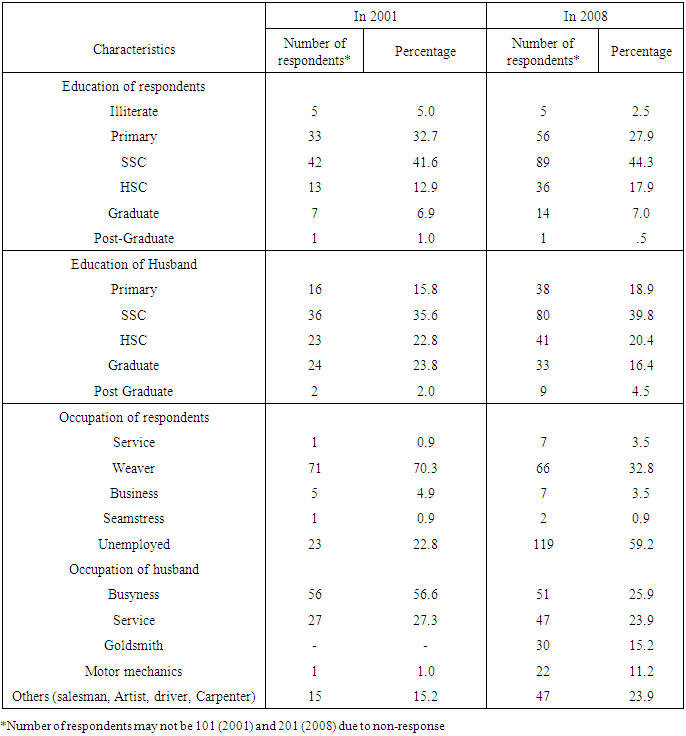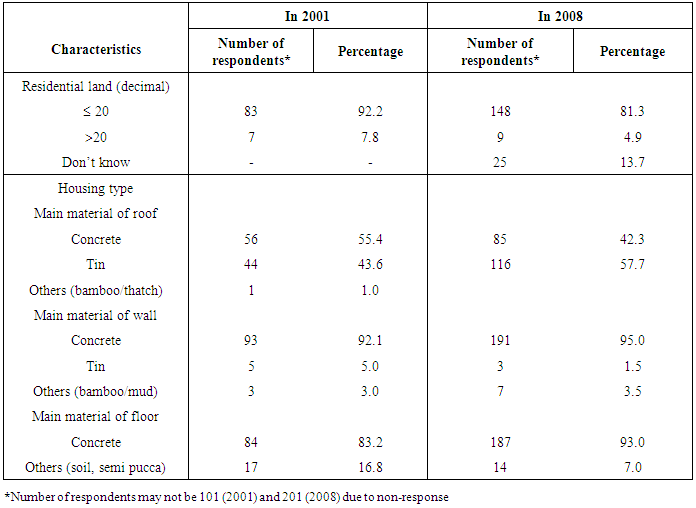-
Paper Information
- Next Paper
- Previous Paper
- Paper Submission
-
Journal Information
- About This Journal
- Editorial Board
- Current Issue
- Archive
- Author Guidelines
- Contact Us
International Journal of Statistics and Applications
p-ISSN: 2168-5193 e-ISSN: 2168-5215
2016; 6(3): 138-144
doi:10.5923/j.statistics.20160603.06

Is Socio-economic Condition of Manipuri Tribe Improving?- A Two Phase Comparison Using Income Distribution Model
Md. Atiqul Islam 1, Md. Tofazzal Hossain 1, Golam Sarwar 2, Luthful Alahi Kawsar 1, Lipi Akter Smrity 1, Md. Ashraf-Ul-Alam 3, Md. Kabir Hossain 1, Mohammad Romel Bhuia 1
1Department of Statistics, Shahjalal University of Science and Technology, Sylhet, Bangladesh
2Business School, University of Greenwich, London, United Kingdom
3Department of Statistics, Jagannath University, Dhaka, Bangladesh
Correspondence to: Mohammad Romel Bhuia , Department of Statistics, Shahjalal University of Science and Technology, Sylhet, Bangladesh.
| Email: |  |
Copyright © 2016 Scientific & Academic Publishing. All Rights Reserved.
This work is licensed under the Creative Commons Attribution International License (CC BY).
http://creativecommons.org/licenses/by/4.0/

Background: Bangladesh has fairly a few varieties of tribal communities living in different parts of the country. Among these Manipuri is the oldest one and underprivileged in terms of socio-economic development and hence, have to face discrimination in education, employment and civil rights. This study is designed to assess changes in their socio-economic condition through a two phases study. Methods: Two distinct sample surveys were conducted in two different phases using cluster sampling procedure to collect the primary data from Sylhet, Bangladesh. The socio-economic condition of Manipuri community was investigated by using various univariate and bivariate statistical tools. Income distribution modelling was applied to estimate income inequality by Gini-Coefficient, Gini’s Concentration Ratio and Lorenz Curve. Results: No mentionable improvement is observed in the level of education though proportion of women with secondary or higher secondary is increased in a very low rate, however, the percentage of higher educated women is decreased substantially. It is unfortunate in Manipuri community that the number of occupied women is decreasing significantly due to lack of better employment opportunity and lack of better facilities for their traditional weaving profession. While the housing condition is bit improved compared to phase one, overall housing condition is not satisfactory. Although average income of Manipuri family is increased slightly, most of the income is concentrated in the hands of a few households. Conclusions: To improve their socio-economic condition, necessary actions should be taken on education, employment opportunity and/or their traditional weaving of Manipuri community.
Keywords: Gini-Coefficient, Gini’s Concentration Ratio, Lorenz Curve, Manipuri, Income distribution, Socio-economic condition
Cite this paper: Md. Atiqul Islam , Md. Tofazzal Hossain , Golam Sarwar , Luthful Alahi Kawsar , Lipi Akter Smrity , Md. Ashraf-Ul-Alam , Md. Kabir Hossain , Mohammad Romel Bhuia , Is Socio-economic Condition of Manipuri Tribe Improving?- A Two Phase Comparison Using Income Distribution Model, International Journal of Statistics and Applications, Vol. 6 No. 3, 2016, pp. 138-144. doi: 10.5923/j.statistics.20160603.06.
Article Outline
1. Introduction
- Among few varieties of tribal communities in Bangladesh, Manipuri community is the oldest one [1]. Majority of the Manipuri people of Bangladesh live in Sylhet division. Like other communities Manipuris have an individual culture and custom Monipuri culture is considered to be one of the oldest cultures in the sub-continent. Monipuri art and culture is the pride of the Monipuri community in Bangladesh [2, 3, 4]. However, it is a matter of great concern that those are fading away [5]. The contrast between one community and other is enhancing noticeable in Bangladesh and Manipuris especially the Manipuri women have to face discrimination in education, employment and civil rights though the income of Manipuri women provides a major contribution to the economic-resources of Manipuri family. They use traditional handloom to make Manipuri bed sheet, bedcover, pillow cover, ladies shawl and woollen shawl are the best in sales [6]. In Sylhet city, Manipuris are concentrated mainly in Sylhet town suburb areas e.g. Lamabazar, Manipuri Rajbari, Laladighirpar, Kewapara, Narsingtilla (Bagbari), Sagardighirpar, Subidbazar (Nayabosti), Ambar-Khana, Gowaipara (Barabazar), Brajanathtilla, Shibganj, Nayabazar and Dakshingachh. The year of forming this settlement is very old [1].Tribal people and their culture is national asset of a country. Like other ethnic minority people of Bangladesh, Manipuri community is underprivileged at every sphere of human development. Moreover, they are deprived of various civil rights and facilities that other indigenous people have. Various national and international organizations are promoting diverse programs to improve the livelihood of different tribal people of Bangladesh but no organization is working specifically for the development of this community. The socio-economic condition of Manipuri community should be developed. Researches to explore their socio-economic condition and reproductive behavior is needed, however there is no mentionable data based research on this community is available. We have taken this opportunity to put forward a study concerning the women of Manipuri community in Sylhet, Bangladesh through this data based research. Through this study, we put forward some suggestions to develop the socio-economic conditions of the people of Manipuri community in Sylhet and in other parts of Bangladesh.
2. Materials and Methods
2.1. Data
- The study is based on primary data. Two distinct sample surveys were conducted in two different phases in the years 2001-2002 and 2008-2009 respectively under the financial support of Ministry of Science and Technology, Government of Bangladesh. In the first phase (in 2001-2002) a total of 101 ever married women and in the second phase (in 2008-2009) a total of 201 ever married women were interviewed. Sylhet city was selected as the study area in a sense that it is considered as the most densely populated area of Manipuri people.
2.2. Sampling Technique
- A cluster sampling procedure was used to collect the primary data. There are thirteen Manipuri paras in Sylhet city. Each of the Manipuri paras of Sylhet city was considered as a cluster. At the first phase (in 2001-2002) four paras were selected at random and covered all the married women. At the second phase (in 2008-2009) eight paras (including four paras of first phase) were selected at random and covered all the married women. A total of 101 women in the first phase and 201 women in the second phase were successfully interviewed.
2.3. Analytical Tools
- An exploratory data analysis was done to have an insight of the data. The socio-economic condition of Manipuri community was investigated by using various statistical tools. Pareto’s law of income distribution, Gini coefficient, and concentration ratio were calculated to investigate concentration of the income distribution of community people. The Gini coefficient is the area between the Lorenz curve of the income distribution and the diagonal line of complete equality [7, 8]. The empirical formula to measure inequality is
 | (1) |
 | (2) |
 is defined as follows:
is defined as follows: | (3) |
3. Results and Discussion
- Education is one of the key determinants of the life style for improving the status of society [9, 10]. A tendency of sending Manipuri girls to secondary and higher secondary classes was much higher than before the liberation war of Bangladesh in 1971. They were used to send to husband’s house, and hence, higher education was not a necessary in an environment where they had to be good house-wives only [6]. About 5% respondents were found with no education in 2001, which diminished to 2.5% in 2008. The proportion of Manipuri women with primary and secondary school certificate (SSC) level education was approximately same for both phases and proportion of Manipuri women with but higher secondary school certificate (HSC) were found 12.9% and 17.9% in phase one and two respectively. Only about 7% respondents were found as graduate in both years. It is also found that husbands’ educational level was better than that of their wives (Table 3.1). Among Manipuri women, about 23% in 2001and 60% in 2008 were found unemployed. Among employed Manipuri women the major portion were involved in weaving followed by business. The figures for weaving (70.3% in 2001 and 32.8% in 2008) indicate that Manipuri women were diverting from weaving to other professions over time. The tendency of involving in service or entering in job market of Manipuri women was increased by 7% from 2001 to 2008. Professionally, the Manipuri people are very closely related to the vast majority of the Bengali community in Bangladesh [11]. The respondents were asked about their husbands’ occupation. It was found that (table 3.1) majority of the husbands were engaged in business (56.6% in 2001 and 25.9% in 2008). No goldsmith was found in 2001 whereas 15.2% were goldsmiths in 2008. Moreover, percentage of motor mechanics was increased from 1 to 11.2.
|
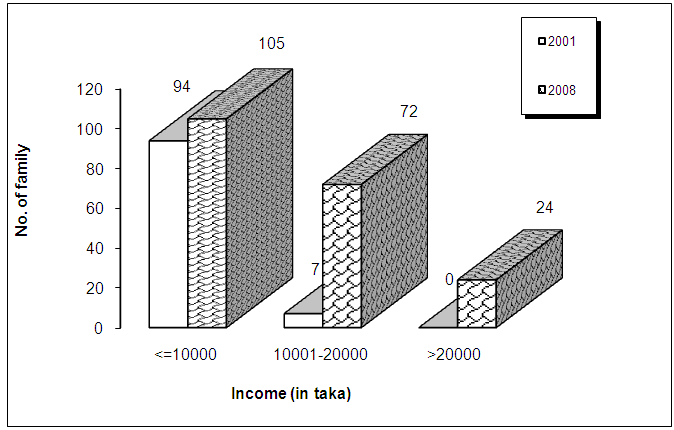 | Figure 3.1. Distribution of monthly family income |
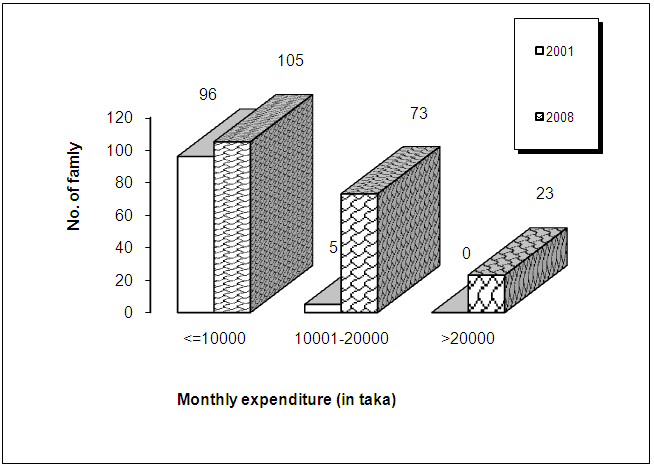 | Figure 3.2. Distribution of monthly family expenditure |
|
 | Figure 3.3. Pie diagrams of respondents family type |
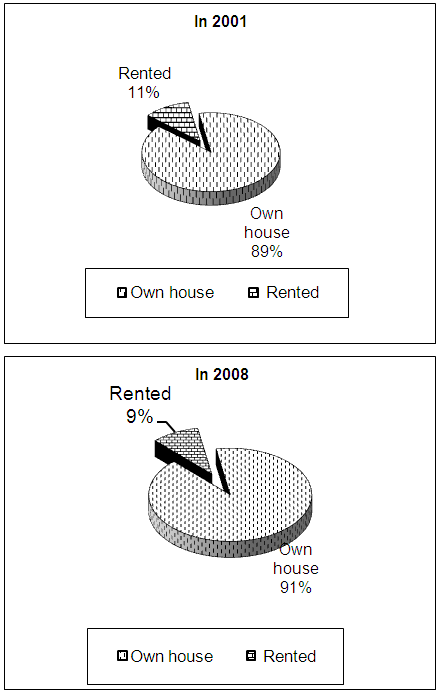 | Figure 3.4. Pie diagrams of present residence statuses of the respondents |
3.1. Income Inequality by Gini-Coefficient and Lorenz Curve Calculation of Gini’s Concentration Ratio
- Concentration ratios show that 57.07% and 55.72% income was concentrated in the hands of a few households and rest 42.93% and 44.28% of the total income was almost equally distributed in 2008 and 2001 respectively as shown in the Table 3.3.
|
3.2. Lorenz Curve
- A common way to analyze personal income statistics is to construct a Lorenz curve (Gujrati, 2004; Koutsoyiannis, 1973). Lorenz Curve provides a visual representation of the information we wish to consider, in this case the inequality of wealth prevailing in Manipuri community over two time period. Figure 3.5 shows that 57.07% and 55.67% income was concentrated in the hands of a few households and rest 42.93% and 44.33% of the total income was almost equally distributed in 2008 and 2001 respectively.
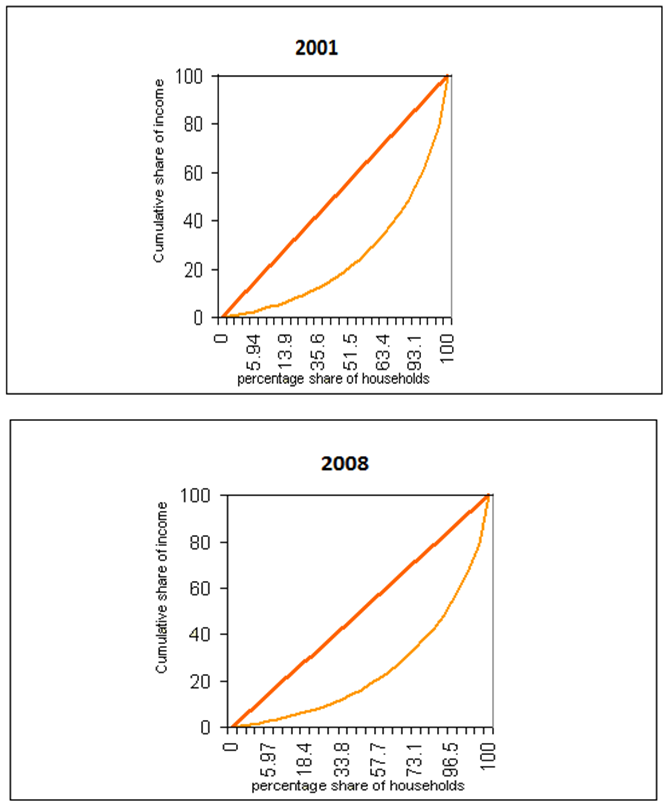 | Figure 3.5. Lorenz Curve of Income Distribution (2001) |
4. Conclusions
- Tribal people and their culture is national asset to a country. Although Manipuri culture is considered to be one of the oldest cultures in the sub-continent, in Bangladesh Manipuri people are deprived of various civil rights and facilities that other indigenous people have. This study is designed to investigate the socio-economic conditions of Manipuri tribe and to see whether there is improvement in their socio-economic conditions in a two phase study. This study is mainly based on primary data and some secondary information is also used for comparison. Sylhet city is selected as the study area in a sense that it is considered as the most densely populated area of Manipuri people. A strong effort is made to ensure a representative sample of the study. In order to reach the ultimate sampling unit, cluster sampling design is adopted. The study is expected to provide the policy makers and planners of Government and Non- Government agencies vital information about Manipuri women and their community needs. No mentionable development had been found in the education sector of Manipuri community from the year 2001 and 2008. Although the percentage of women with SSC and HSC level education was increased in a very low rate, the percentage of higher educated women was decreased by fifty percent. Husbands’ educational level was found better than that of their wives. It is unfortunate in Manipuri community that the number of occupied women was decreasing. The number of women who were involved with different jobs reduced about fifty percent from 2001 to 2008 due to the lack of better employment opportunity and the lack of better facilities for their traditional weaving profession. Manipuri women were diverting from their traditional weaving to other professions like service, business and seamstress. Like women their husbands were also diverting to new professions such as goldsmith, motor mechanics and others from business and service. Average incomes and standard deviations of both years indicate that though the income level was increased in 2008 from 2001, it is true only for few people. Gini’s concentration ratios clarify this fact. Monthly savings extensively decreased since expenditure was increased in a high rate. Where nuclear families are increasing all over the country, different picture was shown in Manipuri community. The number of joint family was increased whereas percentage of nuclear family was decreased than 2001 since their house ownership was not increased as well. Although the housing condition was improved in 2008 as compared with 2001, the overall housing condition was not satisfactory. In spite of living in urban area still now about half of the Manipuri families were living under tin made roof, which represent their poor economic condition.There are some limitations in this study. Firstly, sectarian restriction is a problem in Manipuri community. So, it was cumbersome job to collect information from the people of Manipuri community due to their conservativeness and language (Bengali) problem. For that reason, there may be arisen information bias in the collected data. Secondly, there may be raised non-sampling errors for several data required such as income, expenditure, savings, loan, land ownership etc. because some of the respondents had no correct idea about these variables. Gini Coefficient would work best if data on each and every resident in the Manipuri community is available. This can ensure most accurate Lorenz curve and thus most accurate computation of the coefficient. But in this study, we randomly selected group of Manipuri people which may lead to selection bias in our analysis. It would be interesting if Optimal Data Analysis Paradigm could have been used as a robust statistical method which might be added a new contribution to the investigation [13, 14]. Further investigations should be done in future to have a clear picture of the socio-economic condition of all Manipuri tribe in Bangladesh if data have been collected for each and every people of that community.
ACKNOWLEDGEMENTS
- We acknowledge the invaluable financial support from the Ministry of Science and Technology, Government of People’s Republic of Bangladesh without which this research work would have been difficult to conduct. We are grateful for the generosity of time and effort by the participants and all researchers who make the project possible.
 Abstract
Abstract Reference
Reference Full-Text PDF
Full-Text PDF Full-text HTML
Full-text HTML